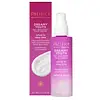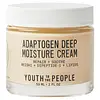What's inside
What's inside
 Key Ingredients
Key Ingredients

 Benefits
Benefits

 Concerns
Concerns

 Ingredients Side-by-side
Ingredients Side-by-side

Water
Skin ConditioningHelianthus Annuus Seed Oil
EmollientEthylhexylglyceryl Palmitate
EmulsifyingAcetyl Hexapeptide-8
HumectantGlyceryl Stearate
EmollientCetyl Alcohol
EmollientPalmitoyl Tripeptide-3
Butyrospermum Parkii Oil
EmollientVitis Vinifera Seed Oil
EmollientAloe Barbadensis Leaf Juice
Skin ConditioningLaminaria Hyperborea Extract
Skin ProtectingTocopheryl Acetate
AntioxidantMagnesium Ascorbyl Phosphate
AntioxidantPrunus Amygdalus Dulcis Oil
Skin ConditioningHyaluronic Acid
HumectantTheobroma Cacao Seed Butter
EmollientPanthenol
Skin ConditioningAllantoin
Skin ConditioningXanthan Gum
EmulsifyingAlgin
MaskingAvena Sativa Bran
AbrasiveCocos Nucifera Water
MaskingIris Pallida Leaf Cell Extract
AntioxidantRosa Damascena Leaf Cell Extract
Skin ProtectingCichorium Intybus Root Oligosaccharides
Skin ConditioningCaesalpinia Spinosa Gum
Skin ConditioningCucumis Sativus Fruit Extract
EmollientPhenoxyethanol
PreservativeEthylhexylglycerin
Skin ConditioningPelargonium Graveolens Oil
MaskingWater, Helianthus Annuus Seed Oil, Ethylhexylglyceryl Palmitate, Acetyl Hexapeptide-8, Glyceryl Stearate, Cetyl Alcohol, Palmitoyl Tripeptide-3, Butyrospermum Parkii Oil, Vitis Vinifera Seed Oil, Aloe Barbadensis Leaf Juice, Laminaria Hyperborea Extract, Tocopheryl Acetate, Magnesium Ascorbyl Phosphate, Prunus Amygdalus Dulcis Oil, Hyaluronic Acid, Theobroma Cacao Seed Butter, Panthenol, Allantoin, Xanthan Gum, Algin, Avena Sativa Bran, Cocos Nucifera Water, Iris Pallida Leaf Cell Extract, Rosa Damascena Leaf Cell Extract, Cichorium Intybus Root Oligosaccharides, Caesalpinia Spinosa Gum, Cucumis Sativus Fruit Extract, Phenoxyethanol, Ethylhexylglycerin, Pelargonium Graveolens Oil
Water
Skin ConditioningGlycerin
HumectantEthyl Oleate
EmollientCentaurea Cyanus Flower Water
Skin ConditioningNiacinamide
SmoothingGlyceryl Stearate Citrate
EmollientBehenyl Alcohol
EmollientLauryl Laurate
Skin ConditioningButyrospermum Parkii Butter
Skin ConditioningAmmonium Polyacryloyldimethyl Taurate
Emulsion StabilisingInonotus Obliquus Extract
Skin ConditioningTremella Fuciformis Polysaccharide
Emulsion StabilisingAcetyl Dipeptide-1 Cetyl Ester
Skin ConditioningGanoderma Lucidum Extract
Skin ProtectingLinoleic Acid
CleansingLinolenic Acid
CleansingOleic Acid
EmollientPhytic Acid
Sodium Hydroxide
BufferingStearic Acid
CleansingWithania Somnifera Root Extract
Skin ConditioningPanthenol
Skin ConditioningTocopherol
AntioxidantCeramide NP
Skin ConditioningC12-16 Alcohols
EmollientHydrogenated Lecithin
EmulsifyingPalmitic Acid
EmollientSimmondsia Chinensis Seed Oil
EmollientSqualane
EmollientArginine
MaskingCaprylyl Glycol
EmollientCitric Acid
BufferingCoco-Betaine
CleansingEthylhexylglycerin
Skin ConditioningFructose
HumectantHelianthus Annuus Seed Oil
EmollientPropanediol
SolventXanthan Gum
EmulsifyingCaramel
Cosmetic ColorantBenzyl Alcohol
PerfumingPhenoxyethanol
PreservativePotassium Sorbate
PreservativeWater, Glycerin, Ethyl Oleate, Centaurea Cyanus Flower Water, Niacinamide, Glyceryl Stearate Citrate, Behenyl Alcohol, Lauryl Laurate, Butyrospermum Parkii Butter, Ammonium Polyacryloyldimethyl Taurate, Inonotus Obliquus Extract, Tremella Fuciformis Polysaccharide, Acetyl Dipeptide-1 Cetyl Ester, Ganoderma Lucidum Extract, Linoleic Acid, Linolenic Acid, Oleic Acid, Phytic Acid, Sodium Hydroxide, Stearic Acid, Withania Somnifera Root Extract, Panthenol, Tocopherol, Ceramide NP, C12-16 Alcohols, Hydrogenated Lecithin, Palmitic Acid, Simmondsia Chinensis Seed Oil, Squalane, Arginine, Caprylyl Glycol, Citric Acid, Coco-Betaine, Ethylhexylglycerin, Fructose, Helianthus Annuus Seed Oil, Propanediol, Xanthan Gum, Caramel, Benzyl Alcohol, Phenoxyethanol, Potassium Sorbate
Ingredients Explained
These ingredients are found in both products.
Ingredients higher up in an ingredient list are typically present in a larger amount.
Ethylhexylglycerin (we can't pronounce this either) is commonly used as a preservative and skin softener. It is derived from glyceryl.
You might see Ethylhexylglycerin often paired with other preservatives such as phenoxyethanol. Ethylhexylglycerin has been found to increase the effectiveness of these other preservatives.
Helianthus Annuus Seed Oil is the oil derived from the seeds of a Sunflower. Sunflower seed oil is non-fragrant. It is an emollient, meaning it helps to soften the skin.
Sunflower seed oil contains many fatty acids. The fatty acids found in sunflower seeds include (from highest amount to least): linoleic acid, myristic acid, palmitic acid, stearic acid, arachidic acid, oleic acid, and linolenic acid.
These fatty acids help the skin create ceramides. Ceramides play a role in repairing the skin barrier.
Helianthus Annuus Seed Oil helps moisturize the skin. This in turn helps the skin look more rejuvenated and smoother.
Sunflowers are rich in vitamin E.
Historians believe Indigenous cultures of North America domesticated sunflowers before corn. Thus they relied on sunflower oil for a variety of uses. One such use is moisturizing skin and hair.
Sunflower seed oil may not be fungal acne safe. We recommend speaking with a professional if you have any concerns.
Learn more about Helianthus Annuus Seed OilPanthenol is a common ingredient that helps hydrate and soothe the skin. It is found naturally in our skin and hair.
There are two forms of panthenol: D and L.
D-panthenol is also known as dexpanthenol. Most cosmetics use dexpanthenol or a mixture of D and L-panthenol.
Panthenol is famous due to its ability to go deeper into the skin's layers. Using this ingredient has numerous pros (and no cons):
Like hyaluronic acid, panthenol is a humectant. Humectants are able to bind and hold large amounts of water to keep skin hydrated.
This ingredient works well for wound healing. It works by increasing tissue in the wound and helps close open wounds.
Once oxidized, panthenol converts to pantothenic acid. Panthothenic acid is found in all living cells.
This ingredient is also referred to as pro-vitamin B5.
Learn more about PanthenolPhenoxyethanol is a preservative that has germicide, antimicrobial, and aromatic properties. Studies show that phenoxyethanol can prevent microbial growth. By itself, it has a scent that is similar to that of a rose.
It's often used in formulations along with Caprylyl Glycol to preserve the shelf life of products.
Water. It's the most common cosmetic ingredient of all. You'll usually see it at the top of ingredient lists, meaning that it makes up the largest part of the product.
So why is it so popular? Water most often acts as a solvent - this means that it helps dissolve other ingredients into the formulation.
You'll also recognize water as that liquid we all need to stay alive. If you see this, drink a glass of water. Stay hydrated!
Learn more about WaterXanthan gum is used as a stabilizer and thickener within cosmetic products. It helps give products a sticky, thick feeling - preventing them from being too runny.
On the technical side of things, xanthan gum is a polysaccharide - a combination consisting of multiple sugar molecules bonded together.
Xanthan gum is a pretty common and great ingredient. It is a natural, non-toxic, non-irritating ingredient that is also commonly used in food products.
Learn more about Xanthan Gum